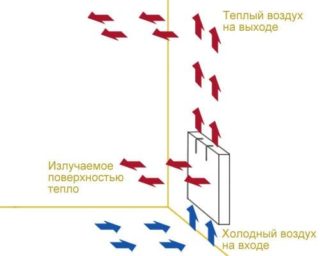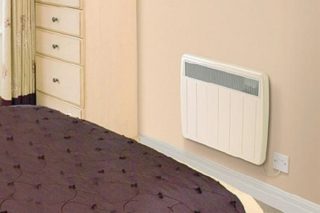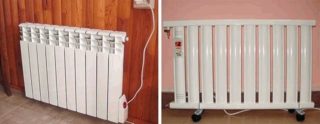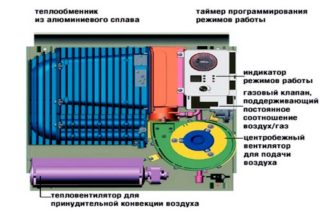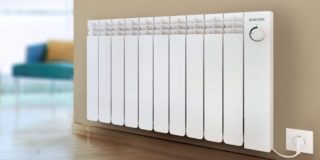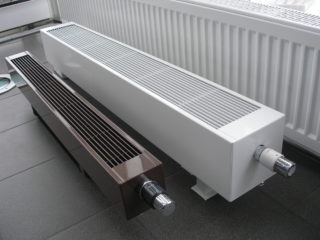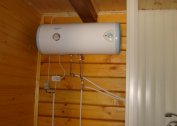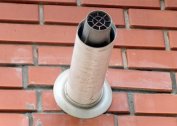The efficiency of the heating system largely depends on the performance of the radiators installed in the room. Convection batteries stand out among their analogues for their high efficiency and wide range of options when choosing equipment: electric, gas, water models are offered.
Convection principle
The convection principle used in heating systems is that when cold air enters the heat radiation zone, it absorbs energy and warms up. At the same time, the air becomes lighter, rises up with the simultaneous transfer of heat to other objects. The lack of constant contact with the source leads to a gradual cooling of the upper air layers. Because of this, they become heavier, fall down and again come into contact with equipment that emits heat.
This cycle is continuous as long as the thermal energy is transmitted by the source. The intensity of the convection process can be increased using specialized equipment. The use of convection heating batteries as part of the system allows you to create a powerful directional air flow. They work with consistently high efficiency and are distinguished by excellent energy efficiency indicators.
Pros and cons of convector radiators
There are quite a few arguments in favor of installing convector-type radiators.
- Simplicity and reliability of the design, which ensures long trouble-free operation of the equipment.
- Safety of use due to the relatively low surface temperature of the case (in most cases, the indicator does not exceed +60 ° C). But at the same time, the temperature of the heated air can be much higher.
- Compact size. A convector radiator will take up no more room in the room than a more traditional steel or cast iron. If necessary, you can choose a narrow model designed for installation under a low window.
- Ease of installation. To do this, just install the brackets, place a radiator on them and connect it to the heat source.
- Functionality. Manufacturers offer a wide selection of models, among which you can choose electronic equipment. With its use, the user will be able to program the radiator, remotely adjust its parameters. Many models allow you to use the energy saving mode, which is especially relevant if the owners are not at home for a long time. For this, the “Anti-freezing” mode is proposed, when turned on, the automation will maintain the temperature of the coolant at a level that will not allow the system to freeze.
Before replacing previously installed radiators of a traditional design with convective heating devices, their disadvantages should be taken into account.
- High energy consumption: 10 kW will require 1 kW / h.
- A significant difference between the temperature above and at the floor level can cause discomfort. When choosing equipment, the design of which provides for the placement of exhaust openings on the front wall, the heating of the air layers will be more uniform.
- Low heating rate in the absence of a fan for forced convection amplification.
- In rooms with high ceilings, the use of convector heating is ineffective.
The constant movement of dust simultaneously with the movement of air in any case cannot have a positive effect on health. This problem may be especially relevant for young children or allergy sufferers.
Varieties of convection equipment
Gas
When choosing a gas convector for a heating radiator will be connected to the central highway. Installation of such equipment is possible only in gasified houses or if it is possible to connect to a cylinder with liquefied gas. The complexity of installation, the need to make approvals for the installation of the unit is offset by high rates of efficiency and energy efficiency.
Water
If you need to choose the cheapest convector in operation, a water-type battery is ideal. Depending on the design features of the existing heating system, you can choose a model with a bottom or side connection. Ease of operation is ensured by the installation of shut-off valves. Water units quickly gain temperature, but are ineffective in use in rooms with high ceilings.
Electric
Electric convectors stand out among analogues by the simplicity of connection and operation, the ability to work with efficiency up to 95% with low noise. As a rule, they are not equipped with fans. Among the shortcomings, it is worth highlighting a significant energy consumption and an increase in utility bills. For higher efficiency, you can choose a model with a thermostat.
Calculation of the required number of radiators
To accurately determine the number of converter batteries needed to heat a room, many factors must be considered. First of all, the building features are taken into account: the material of the walls, the number of windows, their size, the effectiveness of thermal insulation.
Accurate calculations are rarely done. In most cases, use averaged indicators. At the same time, the climatic features of the region are important.
For moderate latitudes per 10 m2 of a room with a ceiling height of up to 3 m, 1 kW of heating unit power is enough. For the northern regions, for example, for Yekaterinburg, this indicator increases to 1.3 kW.
Mounting Features
Installation and operation of heating equipment directly depends on the type and principle of operation of the installed appliances. When connecting a water radiator-convector, it takes into account the characteristics of the material from which it is made. The equipment is mounted on the wall using brackets. To connect to the heating system and supply coolant, special nozzles are used. For joining, you can use steel or plastic pipes.
Installation of electrical equipment is much simpler and does not require the participation of specialists. Before installation, it is enough to consider some safety rules. The distance to the floor should be more than 20 cm, from the outlet - from 35 cm, from the ceiling - from 55 cm, from the wall - less than 25 cm.
For gas units, self-installation is not permitted. Even a detailed study of the information on specialized sites does not allow to avoid errors, which is unacceptable from a security point of view.
